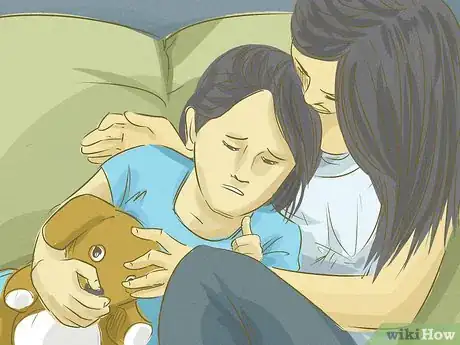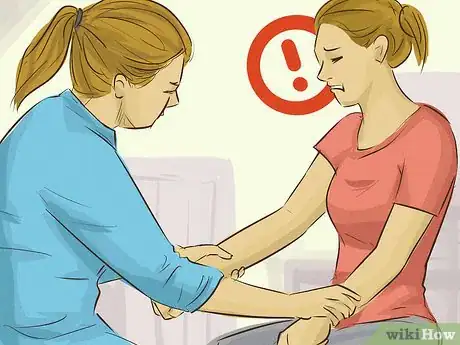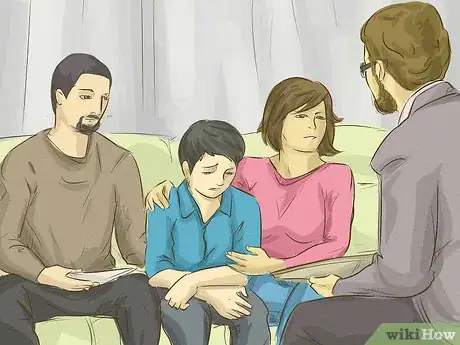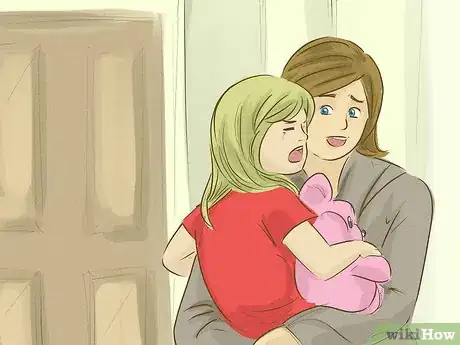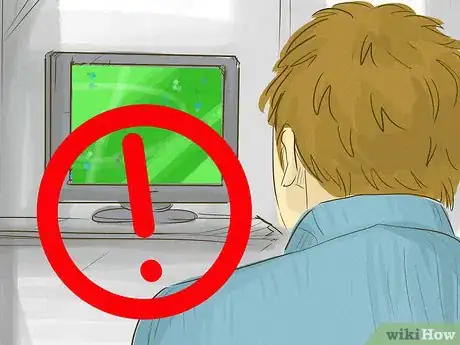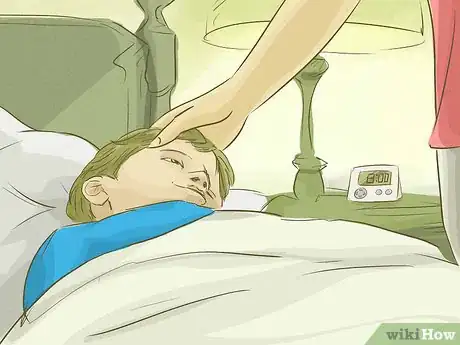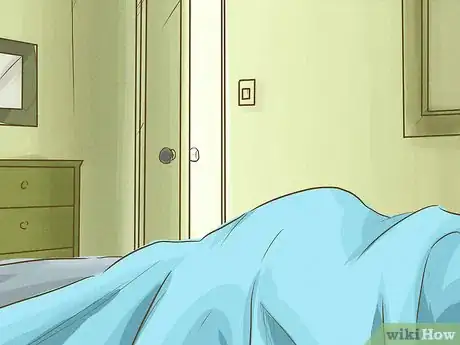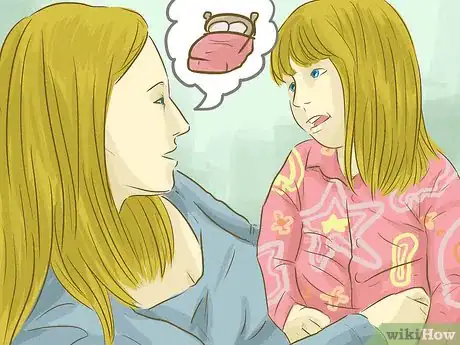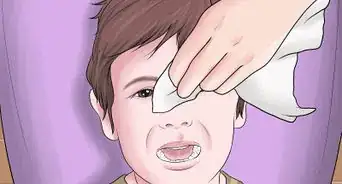X
This article was co-authored by Paul Chernyak, LPC. Paul Chernyak is a Licensed Professional Counselor in Chicago. He graduated from the American School of Professional Psychology in 2011.
This article has been viewed 16,914 times.
Putting your child to bed at night can be a difficult ordeal if they have a fear of monsters. Though these may seem like silly childhood worries, know that your child’s fears seem very real to them. It is important not to trivialize their anxiety, but to acknowledge it and help them move past it. You can help your child overcome their fear of monsters through having a talk with them, altering their bedtime routine, and changing their room around.
Steps
Method 1
Method 1 of 3:
Talking About Their Fears
-
1Affirm their feelings. One of the most helpful points in helping your child move past their fear is acknowledging that the fear exists. Rather than saying things like “Don’t be scared” or “You shouldn’t worry,” you should acknowledge your child’s anxiety so that they feel heard.[1]
- Say something like “I know that you are scared. I’m going to help you, I promise.”
-
2Ask them what they are worried about. Don’t guess or make any assumptions about why your child is scared. Instead, seek to understand through actively listening to them. You might say something like “Tell me what’s bothering you the most.” It is only once you understand their fear that you can help them overcome it.[2]
- Active listening involves more than simply asking your child what's bothering them. Sit down or kneel to get on their level, and make eye contact as they describe their fears. This lets them know you take their concerns seriously.
Advertisement -
3Help them find the facts of their fears. Though you know that your child’s fears are unreasonable, to them they are very real. Help them break down the realities of the situation. After finding out their fears, ask them questions. For instance, if they are worried that a monster is hiding in their closet, ask them if they have ever seen one in there.[3]
- If they are afraid of their dolls at night, ask them if they have ever seen one of their dolls move on their own. This will help jumpstart the process of delegitimizing their worries.
- Very young children may not be as receptive to being told monsters are not real. You may need to help a young child feel ready to take on the threat of a monster. By age six or seven, though, you should be able to speak clearly with your child about fact versus fiction.
-
4Have them draw the monster and make it silly. Another way to help debunk their fears is to assign them a mini art project. Have them draw what they think their monster might look like. After they have done that, have them make the monster look silly by adding polka dots or ice skates or anything else that is funny to them. This will help assuage their fears by adding humor to the idea of the monster.[4]
- Perhaps they could draw them slipping on a banana peel.
- You may also have them write a silly story about their monster, or tell them a story that makes their monster seem like less of a threat.
-
5Reassure them of their safety if they leave their bedroom. Sometimes, your child might feel so afraid at night that they will leave their beds to get in yours. Though it can be tempting to allow them to sleep with you, it is important that you reinforce that their room is a safe place and that they should be sleeping there. Walk them back to their bed and stay for a bit until they fall asleep.[5]
- You might say something like “I know you are scared. But your room is a safe place and it is okay for you to sleep there. I won’t let anything get you. I’m going to stay with you for a little bit until you fall asleep, okay?”
-
6Help your child address and move past actual trauma. Perhaps your child’s fear of monsters stems from some very real traumatic life situation that has occurred. Maybe your home was broken into or they witnessed a violent act. Whatever the cause, help your child move past their issue through conversation and making changes to your home environment.[6]
- You might begin the conversation by saying “I know you are still scared from seeing that fight yesterday. We can talk about it any time you want to. Do you want to talk about it now?”
- You may also ask your child, "What would help you feel less afraid?" They may be able to direct you to a practical answer if asked outright.
- If they are afraid because of a burglar, consider purchasing a home alarm system and explaining to them how it works and keeps bad people out. Lock your windows and doors. Get a guard dog.
-
7Get professional help in severe cases. Sometimes, your child’s fear of monsters might be beyond the scope of just having a conversation or tweaking their nighttime routine. If your child is not sleeping at night, eating less, or if you observe any signs of depression, consider getting them professional help. Look up child therapists in your area.[7]
Advertisement
Method 2
Method 2 of 3:
Improving Their Bedtime Routine
-
1Read a book that helps them overcome childhood fears. Read to your child nightly to help soothe them to sleep. Allow them to select a book of their choosing or consider purchasing books addressing fears of monsters. The movie Monsters, Inc. has also been helpful for some children to humanize monsters. A list of potentially helpful books include:[8]
- The Monster at the End of this Book
- Can’t You Sleep, Little Bear?
- The Owl Who Was Afraid of the Dark
- What a Bad Dream
-
2Schedule time hours before bed to discuss worries. Do some fact checking about their monsters with them earlier in the day rather than later. Rather than always waiting until right before bed to address your child’s concerns, begin talking about them after school or dinner. This will ensure that their worries are being addressed early on, which will help make their transition to sleep easier and faster.[9]
-
3Help them shift their nighttime thoughts. Make a list with your child of different things they are looking forward to, or a list of their general interests. Have them cycle through this list every night so that they have things to think of rather than the monsters.[10]
- This is a great way to shift their focus at night to something more positive and constructive.
-
4Give them a security object. Many children find great comfort in having an item to hold while sleeping. Give your child a special blanket or stuffed animal that they can sleep with to alleviate their fears.[11]
- Consider even giving them one of these items from your childhood. Otherwise, you could also go shopping to allow them to pick out one that is special to them.
- You may even appoint a favorite stuffed animal or toy as a guardian or watcher to place somewhere special in the room where they will be able to watch over and protect your child.
- You can also create a "magic" object that will help protect your child. A spray bottle filled with water could be their monster spray that they use every night before bed.
-
5Don’t allow them to watch any scary shows or movies. Sometimes the monsters that children fear are the monsters they have seen on TV. Though you can’t change what they’ve already seen, you can control what they see hereafter. Don’t allow your child to watch anything scary or anything that is not G or PG rated.[12]
- Consider placing parental controls on their televisions so that they cannot access this frightening material on their own.
-
6Occasionally stay in their bed until they fall asleep. Though you should not make a habit of this, you can occasionally sleep with your child on nights that they are particularly scared. Don’t do this for two consecutive nights, however, or even on a weekly basis. You don’t want you child to be overly accustomed to your presence.[13]
-
7Do periodic check-ins. If your child is very fearful at night, tell them that you will check on them every few minutes until they fall asleep. Consider checking in 5 minutes after they have been put to bed, then 10, then 25. This will help assure them that you are there and that nothing can get to them.[14]
Advertisement
Method 3
Method 3 of 3:
Modifying Their Surroundings
-
1Change the lighting in the room. Though your child may want to keep the lights in their room blazing out of fear of the monsters, this will likely affect their quality of sleep and will not help them face their worries. Purchase some lower wattage lights so that they can keep lights on that will not be overly bright. You can also consider purchasing a night light or keeping a small lamp on by their bed.[15]
- You may also want to work with your child to get comfortable in the dark. Walk through the lit room with them, then turn out the lights and go through the room again, having them touch things to identify them. This can help create some comfort.
-
2Eliminate any shadows. Your child’s fear may arise from the presence of shadows in their room. Eliminate as many shadows as you can. If their coat hanging on a hook makes a creepy shadow, hang it in the closet instead. If their toys are casting a shadow near their bed, place them in a bin instead.[16]
- Take a look at the room from your child's level. Squat down and look at look at everything from about their height to get an idea of what may frighten them.
-
3Move their bed to face the door. One way to help assuage your child’s fears is to have their bed facing the door. If their bed is facing away from the door currently, they may worry that a monster could enter without them knowing. Having them face the door can alleviate that concern.[17]
-
4Consider a pet for companionship. Some children benefit immensely from having a pet with them in their room as they sleep, as it can serve as a constant companion for them in a way that you cannot. Choose one that does not sleep in the bed like a hamster or fish.[18]
- Make sure the pet is not very noisy as well so that it doesn’t affect their sleep.
- If you have a dog, cat, or other large pet, you can talk to your child about how the pet helps keep the monsters away at night. Let your child think your dog is a guard dog.
Advertisement
References
- ↑ https://www.psychologytoday.com/blog/worry-wise/201503/helping-your-anxious-child-overcome-bedtime-fears
- ↑ https://www.psychologytoday.com/blog/worry-wise/201503/helping-your-anxious-child-overcome-bedtime-fears
- ↑ https://www.psychologytoday.com/blog/worry-wise/201503/helping-your-anxious-child-overcome-bedtime-fears
- ↑ https://www.psychologytoday.com/blog/worry-wise/201503/helping-your-anxious-child-overcome-bedtime-fears
- ↑ https://www.cincinnatichildrens.org/health/b/bedtime-fears
- ↑ https://www.cincinnatichildrens.org/health/b/bedtime-fears
- ↑ https://www.cincinnatichildrens.org/health/b/bedtime-fears
- ↑ https://www.familyeducation.com/fun/fear-dark/15-books-help-kids-overcome-their-fears
- ↑ https://www.psychologytoday.com/blog/worry-wise/201503/helping-your-anxious-child-overcome-bedtime-fears
- ↑ https://www.psychologytoday.com/blog/worry-wise/201503/helping-your-anxious-child-overcome-bedtime-fears
- ↑ http://happyhooligans.ca/stop-kids-afraid-bedtime-monsters/
- ↑ https://www.cincinnatichildrens.org/health/b/bedtime-fears
- ↑ https://www.cincinnatichildrens.org/health/b/bedtime-fears
- ↑ https://www.cincinnatichildrens.org/health/b/bedtime-fears
- ↑ https://www.psychologytoday.com/blog/worry-wise/201503/helping-your-anxious-child-overcome-bedtime-fears
- ↑ http://happyhooligans.ca/stop-kids-afraid-bedtime-monsters/
- ↑ http://happyhooligans.ca/stop-kids-afraid-bedtime-monsters/
- ↑ https://www.cincinnatichildrens.org/health/b/bedtime-fears
About This Article
Advertisement




